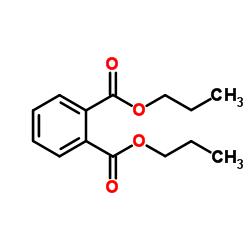Dipropyl phthalate

Dipropyl phthalate structure
|
Common Name | Dipropyl phthalate | ||
|---|---|---|---|---|
| CAS Number | 131-16-8 | Molecular Weight | 250.290 | |
| Density | 1.1±0.1 g/cm3 | Boiling Point | 317.3±10.0 °C at 760 mmHg | |
| Molecular Formula | C14H18O4 | Melting Point | N/A | |
| MSDS | Chinese USA | Flash Point | 166.3±8.5 °C | |
| Symbol |


GHS08, GHS09 |
Signal Word | Warning | |
|
Analysis of phthalates in milk and milk products by liquid chromatography coupled to quadrupole Orbitrap high-resolution mass spectrometry.
J. Chromatogr. A. 1362 , 110-8, (2014) A new analytical method was developed and validated for simultaneous analysis of 27 phthalates in milk and milk products. Response surface methodology was employed to optimize a quick, easy, cheap, effective, rugged, and safe (QuEChERS) sample preparation met... |
|
|
Phthalate occurrence in rivers and tap water from central Spain.
Sci. Total Environ. 500-501 , 139-46, (2014) The aim of this study is to evaluate the presence and concentrations of the main phthalates in water from the Jarama and Manzanares rivers in the region of Madrid (RM, Central Spain), the most densely populated region of Spain, and to determine the possible o... |
|
|
Determination of phthalate esters in vegetable oils using direct immersion solid-phase microextraction and fast gas chromatography coupled with triple quadrupole mass spectrometry.
Anal. Chim. Acta 887 , 237-44, (2015) Phthalates are a group of synthetic compounds mainly used as plasticizers, which have been classified as endocrine-disrupting chemicals and potential human-cancer causing agents. They can be found in high amounts in foods, deriving mainly from plastic packagi... |
|
|
Migrated phthalate levels into edible oils.
Food. Addit. Contam. Part. B. Surveill. 8 , 190-4, (2015) The determination of phthalates in edible oils (virgin olive oil, olive oil, canola oil, hazelnut oil, sunflower oil, corn oil) sold in Turkish markets was carried out using gas chromatography-mass spectrometry. Mean phthalate concentrations were between 0.10... |
|
|
Biodegradation of dipropyl phthalate and toxicity of its degradation products: a comparison of Fusarium oxysporum f. sp. pisi cutinase and Candida cylindracea esterase.
Arch. Microbiol. 184(1) , 25-31, (2005) The efficiency of two lypolytic enzymes (fungal cutinase, yeast esterase) in the degradation of dipropyl phthalate (DPrP) was investigated. The DPrP-degradation rate of fungal cutinase was surprisingly high, i.e., almost 70% of the initial DPrP (500 mg/l) was... |
|
|
Reproductive toxicology. Di-n-propylphthalate.
Environ. Health Perspect. 105 Suppl 1 , 257-8, (1997)
|
|
|
Effects of phthalate esters on the sensitization phase of contact hypersensitivity induced by fluorescein isothiocyanate.
Clin. Exp. Allergy 36(11) , 1462-8, (2006) Many different types of phthalate ester are used as plasticizers and are thus found in the air. There have been several studies that suggest an association between allergies and phthalate esters. We previously found that di-butyl phthalate (DBP) has an adjuva... |
|
|
Chemical characterization of bovine urine with special reference to oestrus.
Vet. Res. Commun. 24(7) , 445-54, (2000) Cows' urine was analysed by gas chromatography mass spectrometry (GC-MS). The profiles from preovulatory, ovulatory and postovulatory samples were compared to establish any qualitative and quantitative differences that might have potential value in olfactory ... |
|
|
Differential immune responses of the green neon shrimp (Neocaridina denticulate) to dipropyl phthalate.
Fish Shellfish Immunol. 31(3) , 511-5, (2011) This study set out to understand the sublethal effect of xenobiotic phthalate esters (PAEs) on the relationship between the susceptibility of shrimp to bacterial infection and the immune response of the shrimp. Neocaridina denticulate were exposed to differen... |
|
|
Effects of phthalate esters on dendritic cell subsets and interleukin-4 production in fluorescein isothiocyanate-induced contact hypersensitivity.
Microbiol. Immunol. 51(3) , 321-6, (2007) Phthalate esters with short alkyl chains, such as di-ethyl (DEP), di-n-propyl (DPP), and di-butyl phthalate (DBP), have adjuvant effects on an FITC-induced contact hypersensitivity mouse model. The adjuvant effects of DPP and DBP are associated with enhanced ... |